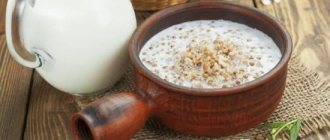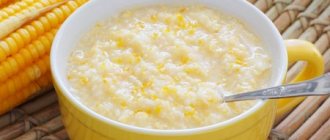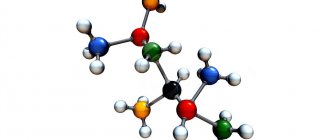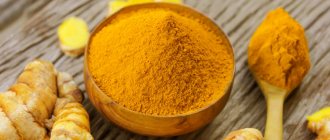Corn porridge for weight loss can be used in various diet options: gentle with a long-term perspective or strict with quick results. An important advantage of a cereal diet is the composition of the porridge, rich in vitamins and nutrients. In addition, corn grits satisfies hunger well and keeps you feeling full for a long time.
Corn grits - what do we know about it?

Many modern nutritionists strongly recommend eating food made from corn products. They claim that it is very healthy, because corn contains protein elements, carbohydrates, fat, fiber and some microelements that every person needs:
- corn porridge is one of the main digestive aids; it is rich in fiber, which helps to establish metabolic processes and helps in the production of enzymes;
- selenium, which is in its composition, strengthens the health of the body;
- lovers of corn porridge receive the necessary microelements and vitamins, which have a positive effect on the condition of bones, hair, and nails;
- corn is a great helper in the process of removing radionuclides and toxins;
- vitamins help keep the nervous system in good condition, it’s not for nothing that corn is considered a natural antidepressant; those who like to use it are usually in a great mood.
Corn porridge for dieting. Allowed foods for diet 5 table
Below is a list of products for the fifth table diet menu, on the basis of which you can build a diet and eat them regularly. But also keep in mind that what is possible with the 5 table diet can be adjusted by a doctor.
| Beverages | Weak tea (you can add milk), with honey or sugar, compotes and jelly from non-acidic fruits and berries, herbal teas, unsalted vegetable juices. |
| Sweets - in small quantities! | Puffed rice, jam, marshmallows, marmalade, mousse, honey, pastille, dry cookies, jelly candies. |
| Baked fruits | Apples, pears, peaches, apricots - you can cook them separately or add them to baked goods |
| Dried fruits | Non-acidic prunes, dried apricots, raisins, dates |
| Steamed cereals and porridges | Buckwheat, rice, semolina, wheat groats, couscous are allowed. You can use them as a side dish or cook them with milk. |
| Milk products | The list of products for the fifth table diet allows you to consume only non-acidic and low-fat dairy products. Unsalted homemade cheese is allowed. |
| Meat | You need to choose dietary types of meat without fat. |
| Bread and pastries | The list of products at table 5 allows the use of white and gray bread aged for a day. Baking is allowed without fats and baked goods, with filling in the form of cottage cheese or fruit. |
| Eggs | You can eat chicken and quail eggs. They need to be boiled exclusively soft-boiled or steamed omelet. |
| Soups | Vegetable soups are recommended, without fat and rich broths. |
| Fish | What you can eat at table 5 also includes boiled, stewed, baked or steamed fish. Choose low-fat types, sea or river. Seafood is also allowed. |
| Vegetables | You can boil them or steam them, eat them stewed or pureed. You need to choose non-starchy vegetables. |
| Sauces and dressings | The list of products for diet table number 5 allows you to supplement dishes with low-fat gravies based on vegetable broths, low-fat sour cream or milk. |
A little history
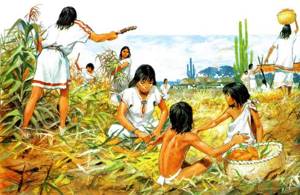
Corn is an ancient agricultural crop. Back in the fifteenth century, it was discovered in the European part of the world, and Columbus introduced America to corn almost 9 thousand years ago. There it became the basis of home nutrition, and the ancient Aztecs gave it the name maize.
In those distant times, corn cobs were very small, no more than 4 cm, which is 10 times smaller than modern types. The plant was domesticated on the territory of ancient Mexico, and later breeding work was carried out to increase the variety of crops. Now Mexico has many varieties of different sizes, tastes and colors - yellow, white, red, blue, and black cobs are famous.
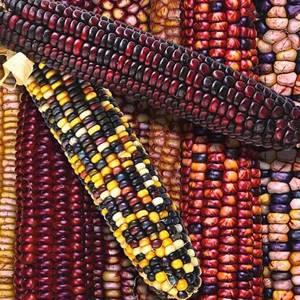
Europe quickly learned to cultivate the plant; corn became especially widespread in countries located in the Mediterranean Sea. From there, in the seventeenth century, the grain crop came to Russia, where over time it became widespread. At first, they began to distribute its seeds free of charge to everyone who wanted them, then they encouraged ordinary traders to trade in boiled cobs. To do this, large vats were installed on the streets of different cities, corn was boiled in them and immediately sold to the townspeople. Thus, people began to be encouraged to grow this crop.
Today, corn grows throughout the vast territory of the Russian Federation and is widely popular among the population, because it is a filling, tasty and healthy snack and has healing properties.
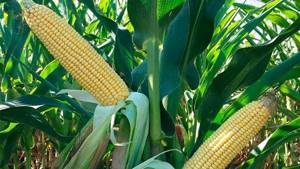
The plant itself is considered environmentally friendly, its roots do not accumulate fertilizers, and chemical elements do not penetrate into the cobs.
Advantages
Recently, the use of cereals in dietary nutrition has been gaining popularity. Their main advantage is suppressing the feeling of hunger. Let's look at what components help in the fight against kilograms.
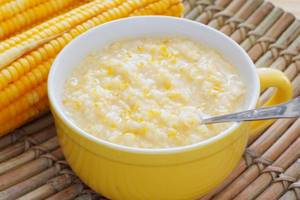
Complex carbohydrates
They give the product a relatively high calorie content (328 kcal per 100 g). At the same time, time and energy are spent on their splitting. Glucose (the end product of carbohydrate breakdown) enters the blood in small portions and is maintained at a constant level. The brain does not lack carbohydrates, there is no feeling of hunger. This paradox has long been used by nutritionists to “deceive” the body with the help of “slow” carbohydrates.
Cellulose
The benefits of plant fibers are as follows:
- swell in the stomach, creating a feeling of fullness with a relatively small amount (decreased appetite);
- pass through the digestive tract unchanged, removing toxins and many toxic substances that have settled there (for example, pesticides and heavy metal salts that come to us with poor-quality vegetables and fruits).
Cleansing the body with corn porridge is used not only for weight loss. Doctors prescribe this dish for many diseases, since such “cleansing” is more physiological and safe.
Unsaturated fatty acids
Contains arachidonic, pantothenic and linolenic acid. These are “golden” substances that are important for many processes:
- reduce cholesterol and triglyceride levels in the blood;
- reduce the accumulation of fat cells and stimulate lipolysis (the breakdown of fats);
- When combined with regular exercise, they lead to muscle growth.
People who follow traditional diets that limit fatty foods and meat products do not get enough of them. Corn porridge completely solves this problem.
Essential amino acids
Tryptophan, histidine, lysine, cysteine, arginine - normalize metabolism, because most “regulators” (hormones and enzymes) have a protein structure. Why is this important for weight loss? Only a healthy body can maintain optimal body weight for a long time. If your metabolism is disturbed, then you can lose kilos, but they will quickly return with a normal diet.
Composition and medicinal properties of cereals
Corn is considered one of the types of high-calorie grains; 100 grams of grains contain up to 340 calories, which is much more than high-calorie beans. Young cobs are considered healthy; they are rich in carbohydrates, sugars, fats, proteins, dietary fiber, vitamins and starch.
The vitamin group is represented by choline (B4), which protects the cell membrane and normalizes cholesterol in blood cells. The mineral group helps improve the state of nervous and metabolic processes, maintain normal body weight, and maintain the beauty and health of the body.
The grain crop has long been used in folk medicine; its soft “stigmas” have long been used to treat diseases.
They are still used in traditional medicine, but it is not recommended to carry out treatment on your own without consulting a doctor. There are a sufficient number of contraindications to the use of stigma and grains.
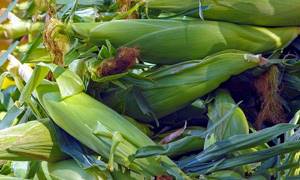
However, they have healing and healing properties:
- help lower blood sugar;
- have diuretic and choleretic effects;
- reduce bilirubin;
- have antihelminthic effects.
Cholelithiasis, cholangitis, some types of hepatitis, and cholecystitis are treated with decoctions prepared at home or an extract purchased from a pharmacy chain. Long-term use of decoctions and extracts will help dissolve kidney stones.
The benefits of cornmeal dishes

Corn dishes contain carbohydrates, proteins, and insoluble fiber, which have a positive effect on the digestive system. There is no gluten in the porridge, so it is actively used in baby food.
Cereals contain the necessary components:
- vitamins B1, B5, they help prevent depression;
- vitamin E - to improve the appearance of hair and nails;
- silicon affects the function of the digestive organs;
- iron and copper are involved in hematopoiesis processes;
- A sufficient amount of phosphorus has a positive effect on the state of the nervous system.
The fiber present in cereals helps cleanse and remove toxins from the body and restore the balance of metabolic processes.
Popular corn dishes add variety to a family's diet. They help improve immunity and restore the body after illness. They are recommended for use for diseases:
- endocrine system;
- liver disorders;
- changes in the gastrointestinal tract;
- oncology;
- diseases of the heart and blood vessels;
- slowing down the processes of fermentation and putrefaction in the intestines.
Despite the benefits of cereals, its use may be contraindicated:
- with ulcerative manifestations in the stomach and intestines;
- with rapid blood clotting.
Therefore, if you have chronic diseases, it is recommended to consult a doctor about the possibility of including popular dishes in the daily menu.
What types of cereals are there?

Corn grits are made from the kernels of the cob. During processing, the endosperm remains, and the husk remains from the shell and embryo.
In the production of cereals, grain varieties are used that have a certain proportion of the content of glassy and mealy parts in the grain.
The following types of cereals are made:
- polished;
- large;
- small.
Corn grits are used to prepare porridge, hominy, soup, casserole, and cottage cheese filling.
Let's look at each type:
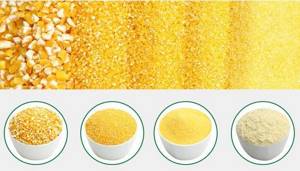
- Polished grain. Crushed particles of corn kernels of various shapes are obtained by separating the fruit shell and the embryo, which are ground until the edges are rounded. Depending on the size of the grain, polished grain is divided into several numbers. Polished cereals are used to prepare a variety of dishes.
- Large grain. Produced for the production of flakes and popcorn.
- Small grains. It is used to make crispy sticks with a variety of flavors.
How to store?
To extend the shelf life and preserve the beneficial properties of corn grits, you should remember the storage conditions and periods.
Conditions
After purchasing corn grits, you should pour it into a dry glass jar with a tight-fitting lid. The jar itself must be stored out of reach of direct sunlight at a temperature of -5...+5°C. The closest place to such conditions is the refrigerator.
You should not store corn grits on shelves above the kitchen stove: this is a place of high humidity, and in such conditions the grits will begin to mold faster.
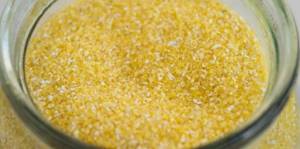
Term
The shelf life of corn grits is 6 months. However, at home it is difficult to maintain the temperature required for storage, so it is better to buy fresh cereal before each cooking.
The best cereal producers
In Russia, the cereal products market is stable and has good growth dynamics. The best manufacturers operating on a wholesale scale are leading Russian companies and holdings.
- Agapov Company
It has been operating in the market of cereal producers since 1998, specializing in the production of popular cereals, bran and waste for pet food.
All products are certified and meet the requirements of state standards. Products are regularly tested for quality control in the company's laboratories.
The company produces ground corn grits No. 4, corresponding to GOST 6002-69.
- TP Ambarel Company
The company's products participate in agricultural exhibitions at the republican and all-Russian levels, where they receive prizes for the quality of their products.
The production facilities produce and sell two types of corn grits – white and yellow.
White cereals contain a large amount of protein, while yellow cereals contain a lot of carotene. The products are packaged in polypropylene bags weighing 800 g.
- Raduga Group of Companies
The company produces and sells corn processing products; annual volumes reach one hundred thousand tons.
The production complex is equipped with the best modern equipment, which produces a large volume of products sold on the domestic market and in neighboring countries.
The company produces three types of cereals, all of which comply with established government standards. The products have a high content of proteins (up to 8.3%) and carbohydrates. Humidity does not exceed 15%.
How to choose?
When choosing corn grits, you need to pay attention to:
- Packaging integrity. Damaged packaging allows moisture to pass through, which means the cereal may become moldy.
- Color and consistency of the product. Often, cereal packaging has a so-called transparent window, which allows you to evaluate the appearance of the contents. Corn grits should have a yellowish matte tint. A high-quality product has a uniform consistency, without lumps, small debris and other impurities.
- Best before date.
Home cooking
The grains contain a sufficient amount of vitamins and minerals, which were already mentioned above. An important element in the composition of cereals is carotene; it contributes to the appearance of vigor and energy necessary for every person.
Eating cereals is especially beneficial for the elderly population with a sedentary lifestyle. It helps everyone who is losing weight to remove excess fat from the body and does not cause excess weight.
Corn dishes have a beneficial effect on the condition of children and adults. The process of preparing them is very simple and does not require much time.
Let's look at some recipes for preparing simple, quick, tasty dishes.
The most common is mamaliga, a thick porridge that is a traditional dish of Moldavian cuisine. A variety of ingredients are added to it to make the food incredibly tasty.
Mamaliga with omelet, ham, tomato

To prepare a quick and high-calorie family breakfast, you need to prepare the following products:
- corn porridge with milk 600 g;
- eggs in the amount of 6 pieces;
- milk 200 ml;
- ham 400 g;
- ghee 100 g;
- green onions 300 g;
- small tomato 3 pieces;
- salt to taste.
Preparation:
- In the evening, cook porridge with milk. Transfer it to a cloth napkin.
- In the morning, cut the porridge into cubes into several pieces 1.5 cm thick.
- Grease a frying pan with oil and put a piece of hominy there.
- Cover the top with tomato slices, cut the ham into cubes, and place it on the tomatoes.
- Pour liquid oil over everything and place in a hot oven for baking.
- Beat the eggs, doubling their volume, add salt and pour a glass of milk into the airy mass.
- Pour the prepared omelette on top of the already baked hominy and place it in the oven for baking, lowering the temperature to one hundred degrees.
- After the omelette is ready, pour the remaining oil over everything and sprinkle the dish with chopped green onions.
Water porridge cooked in a slow cooker
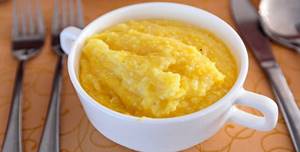
The ideal dish for a healthy diet is lean corn porridge cooked in a slow cooker.
It cleanses the body well, is rich in healthy vitamins and microelements, and when cooked in a slow cooker it turns out especially tasty.
Ingredients:
- corn grits - 360g;
- water - one liter;
- salt to taste.
Preparation:
- Rinse the cereal.
- Place clean kernels into the multicooker bowl.
- Pour in water, salt, and close the bowl with a lid.
- Select the “porridge” program and set the cooking mode to 1.25 hours.
- After the sound signal that the dish is ready, take out the porridge and put it on plates.
The food turns out tasty and nutritious.
Nutritional value of 100 g of product is:
- calorie content 89 cal;
- proteins – 2 g;
- fats – 0 g;
- carbohydrates – 20 g.
Casserole made from cereals and milk
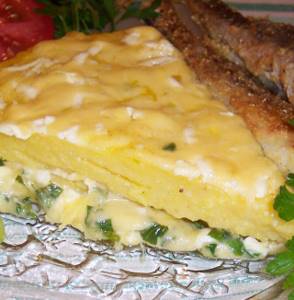
Breakfast casserole is a delicious and healthy dish. Children love it for its delicate taste, and housewives love it for its short cooking time.
Let's prepare the ingredients:
- medium fat cottage cheese 200 g;
- corn grits 200 g;
- one egg;
- milk 200 ml;
- sugar 20 g;
- butter 10 g;
- salt, sugar, vanillin, baking powder.
Step-by-step cooking instructions:
- Put the curd mass into the prepared container, beat the egg into it, add salt and sugar and grind the mass with a blender.
- Pour the cereal into a second container, fill it with hot milk, leave for a quarter of an hour, wait for the consistency of thick porridge to form.
- Mix the curd mass with the porridge.
- Add vanillin (you can also add chocolate products or existing fruits).
- Pour a handful of semolina into the bottom of a greased pan, spread the curd mixture, which we bake in an oven preheated to 180 degrees for thirty minutes.
- Take out the finished dish, place it on a plate and let it cool slightly.
Nutritional value of 100g casserole:
- calorie content 217 cal;
- proteins – 10 g;
- fat – 7 g;
- carbohydrates – 31 g.
A wide variety of foods are prepared from corn: cereals, salads, casseroles, cookies.
Let's look at the best cereals that are highly popular among customers.
Alternative uses
Corn grits are used not only as a food product. There are alternative uses for cereals, such as fish bait or slug repellent.
How to make bait for fishing?
Groundbait made from corn grits is used when catching large species of fish. Fish such as crucian carp, carp, carp, carp and roach prefer corn grits.
You can make bait in two ways:
- Cook. To do this, cook a kilogram of crushed cereal over low heat for 5-7 minutes. A couple of minutes before the end of cooking, pour several glasses of corn flour and cake, and 1 glass of corn flour into the saucepan. Add 50-70 ml of sunflower oil there and cook for the remaining time. To enhance the smell of the bait, add dill and anise flavoring. When the porridge is ready, cool it and form small balls. The advantage of this method is that when they fall into the water, the balls are not carried away by a fast current and are not destroyed instantly, which makes it possible to effectively lure fish in a certain area.
- Steam it up. The desired amount of crushed cereal is poured into a pan, poured with boiling water and the dishes are wrapped in a warm blanket for 2-3 hours. At this time, the second component of the bait is prepared. A piece of stale bread is soaked in warm water until completely limp. Dry flour and a little sunflower oil are added to it. After 2-3 hours, corn grits are mixed with stale bread and left until the morning.
Corn grits against slugs
To get rid of slugs, you should use an old folk method - a trap made from corn grits. It can be done as easily as possible: several grains of corn grits (finely ground or, even better, corn flour) are poured into 0.5-liter jars, which are placed in places where slugs are most concentrated. It is better to place the jar on its side so that the mollusks can climb inside. The smell of corn grits attracts slugs, but after tasting the bait, the pests die.
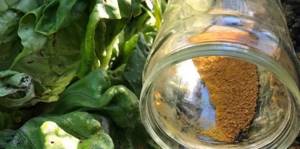
Corn grits have many beneficial properties and are gluten-free. Thanks to this, corn porridge is a safe, and most importantly, favorite dish for kids and adults.
